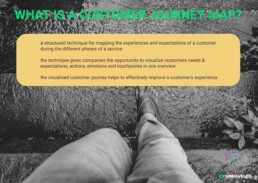Customer Journey Maps: Hype or Hope?
Over the past months quite some companies have approached us with the request to help them create customer journey maps. Which got us thinking - is this a hype which will blow over? Or is it the start of a hopeful process towards creating better customer experiences? I definitely think it should be the latter – HOPE. However, in order for customer journey maps to lead to better customer experiences, there are some important conditions which need to be met.
Before we dive deeper into these conditions, I’d first like to briefly share with you what a customer journey map is.

To elaborate more on this, a customer journey map literally visualizes the steps a customer takes when they interact with a specific service (or product for that matter) offered by a company. By understanding which steps a customer takes and examining their emotions during these steps, we’re given pretty important clues about which aspects of the customer journey need improvement. You’ve got it – one of the first things is to examine the steps where customers experience a negative emotion and see if you can improve those.
Now, back to the important conditions which need to be met in order for customer journey maps to actually lead to better customer experiences:
- Always base your customer journey maps on data verified persona’s. If your company has 6 different persona’s for instance, you need to create a journey map for each of these as your the needs, emotions and actions of these persona’s could differ greatly. Imagine the difference between the customer journey’s of a mom with children and a senior citizen in a supermarket. We know of a Dutch bank who actually has 300 different customer journeys – a mix of persona’s and the different products & services they offer.
- If you choose not to map a customer journey together with your customers (which might not be a bad choice if you have a lot of internal uncertainty which needs to be solved first), see if there is prior research & data available on which you can base your work. After that, do make sure that you validate the customer journey you created with actual customers who fit your persona. You might be surprised how many assumptions or hypotheses you have which don’t hold true when actually validating with customers.
- Once you’ve created and validated your customer journey map – SURPRISE – you’re not done. A customer journey map is not an end product, but a living document. If you want to ensure you deliver a consistent & great customer experience, you need to put into place measurements which help you monitor whether you are achieving the desired experience. Once those measurements dive under your target, it’s time to take a deeper look at that specific step in the customer journey and see how you can improve it. Make sure your management is also aware of this and support your continuous efforts to improve the customer experience.
If you take these conditions into account when mapping your customer’s journeys, you’re starting with a solid basis to actually create great customer experiences. Go for it! And if you need any help, don’t hesitate to reach out to us.
